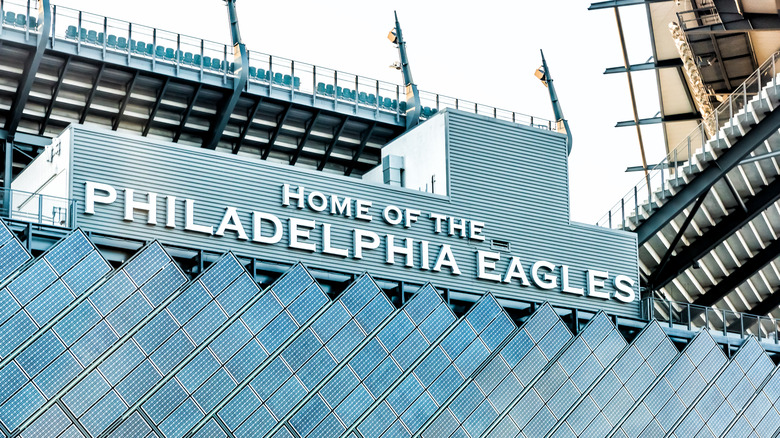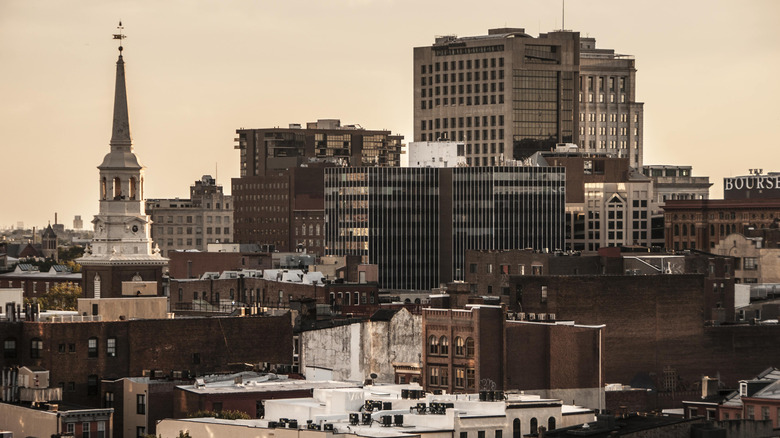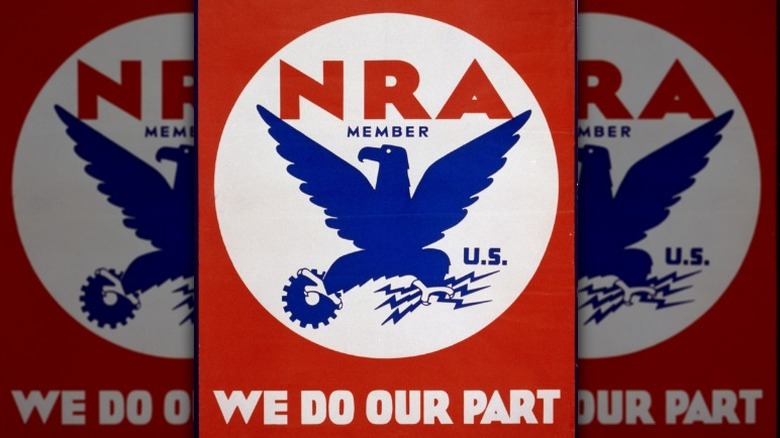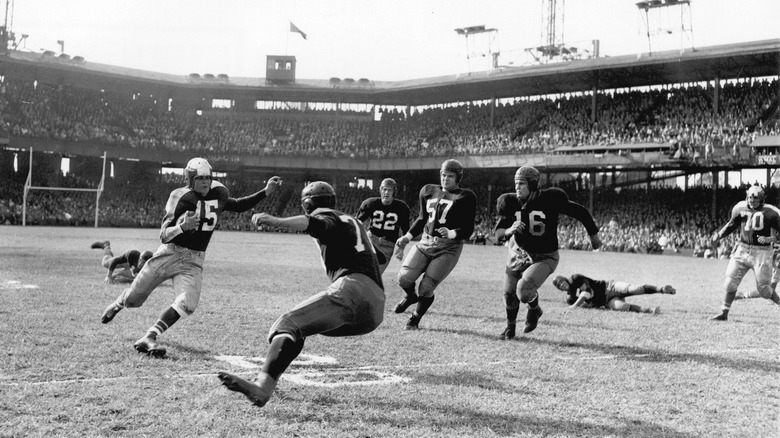How The Philadelphia Eagles' Name Draws Inspiration From FDR's New Deal
Whether it's football season or not, the city of Philadelphia has an incredibly strong sense of pride when it comes to their team, the Philadelphia Eagles. For many Philadelphians, barely a day goes by without worrying over the latest tidbit of Eagles news that they think will make or break the team's chances of making that year's Super Bowl. It could be the hottest day of summer — in the middle of Phillies season, mind you — and you'd still see fans wearing their favorite Eagles jersey. There's little doubt that person would be met with a "Go, Birds!" or a "Fly, Eagles Fly!" or even an "E-A-G-L-E-S!" from complete (but utterly sincere) strangers. And if it's a less-than-successful year, they focus on their most despised team, the New York Giants.
But where did all this bird love originate? It's not like Philadelphia is located in an eagle haven like Alaska. Per Sportscasting, it all goes back to 1933 when Philadelphia natives De Benneville "Bert" Bell and James Ludlow "Lud" Wray — a pair of former professional football players — formed a group to buy the recently defunct Frankford Yellow Jackets for $2,500. Although the Yellow Jackets existed for more than 30 years and won the NFL championship in 1926, the organization suffered a number of unlucky events and had to shut down in the middle of the 1931 season. Still, Bert Bell and Lud Wray saw an opportunity; it would require a new location and a new name. But what?
Finding a new name
Bert Bell knew he wanted to go bigger than Frankford's nod to the section of Philadelphia where its stadium was located. He wanted a name for the team that reflected the entire city — one that would carry a certain heft. So one day, when Bell was out and about in the city, it came to him. "He was walking down the street and looked up at a billboard that had the National Recovery [Industrial] Act eagle up there ... [He] decided on the spot: 'That's the name of my team,'" Upton Bell, Bert's son, told The Game Before the Money podcast. It's rare that private enterprise is creatively inspired by the government, but there it was. Bell saw a billboard that was advertising a government program with a massive Blue Eagle, and he determined the name of their new team would be the Philadelphia Eagles.
That law, the National Industrial Recovery Act of 1933, established the National Recovery Administration. According to the National Archives, it was meant to regulate industry to provide economic relief to citizens as a part of President Franklin D. Roosevelt's overall New Deal program to stimulate economic recovery as a response to the Great Depression. Per Slate, the act went into effect in June 1933 and aimed to stabilize production, regulate wages and consumer pricing, and guarantee laborers a right to collective bargaining. Antitrust laws were suspended to allow the various trades to set many of the standards for themselves.
The Blue Eagle became a symbol
The federal government made appeals of patriotism to comply with the new sets of regulations and laws. For their part, firms were asked to display the Blue Eagle, the symbol of National Recovery Act compliance and participation. Per the Library of Congress, workplaces could only display the Blue Eagle if they abided by the entire set of labor standards, including an increase in workers' wages and a maximum number of hours they could work. Roosevelt hoped that patriotic consumers would only shop at stores that displayed the Blue Eagle, which would force companies that dragged their feet into compliance.
The Blue Eagle was designed by Charles T. Coiner, a noted painter and the former art director of the N.W. Ayer advertising agency in 1933. According to The New York Times, Coiner was one of the first art directors to commission the work of fine artists to do work in the advertising world. However, for the National Recovery Act (NRA), he did the artwork himself after a few failed attempts from his underlings. With its wings spread, the eagle holds a gear in its right talon to symbolize industry, per the National Button Society. And in its left talon, it grasps bolts of lightning to symbolize power. "We Do Our Part," the NRA's slogan, typically appeared below the eagle — an attempt to draw in consumers to a collective effort.
The Blue Eagle takes off
Before long, the Blue Eagle wasn't just on display in stores and other businesses. According to an article in Essays in Economic & Business History, manufacturers began placing the logo on the packaging of a broad range of consumer goods (and their ads), including clothing labels, produce crates, razors, and office supplies. At home, citizens began to stitch the Blue Eagle into their quilts and tapestries, some of which made their way to the White House as gifts for the Roosevelts, per the National Archives. Eventually, the Blue Eagle was incorporated into the consumer products themselves. In the middle of all this, Bell and Wray named their new team the Philadelphia Eagles. According to CNN, the two decided to honor the symbol of the NRA, but it could have just as easily been an opportunistic moment.
The Philadelphia Eagles made their NFL debut on October 15, 1933, but it wasn't exactly the kind of jump start Bell and Wray — or the city, for that matter — were hoping for. It was a 56-0 blowout at the hands of the New York Giants, per the Bleacher Report. By almost every form of measurement, it was a rough first decade for the Eagles. However, that changed in 1948 and 1949 when the team locked down two back-to-back NFL championships. Philadelphia took home another national title in 1960, but it didn't win its first Super Bowl until 2017.



